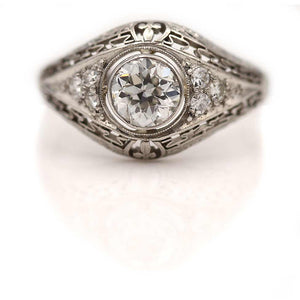What is Filigree? | The Definitive Guide to Filigree Rings
Jul 12, 2024
by Suzanne Sachs • 5 min read

THE BASICS --
Filigree can be a stunning accent on an engagement ring, cocktail ring, anniversary ring, wedding band, or any other jewelry, but what is it, exactly? What should you be aware of about filigree before you purchase such a piece?
WHAT YOU NEED TO KNOW--
In this guide, we will explain the following:
- What is Filigree?
- History
- What Filigree is Not
- Is Filigree Right For You?
- Pros of Filigree Rings
- Uniqueness
- Beauty Without Gemstones
- Small Business Support
- Conflict Free Diamonds
- Eco-Friendly Settings
- Cons of Filigree Rings
- Difficult To Match
- Harder To Find
- Care and Maintenance Costs
- Buying a Filigree Piece
- Caring for Filigree
- Choosing a Filigree Ring
What Is Filigree?
Filigree is intricate, delicate metalwork created by twisting, knotting, or curving thin wires into exquisite patterns. The ornamental work is then either formed into an openwork jewelry piece or mounted on a solid piece to create a decorative surface. Patterns such as scrolls, vines, flowers, hearts, leaves, sunbursts, and geometric symmetry are all popular options. Overall, the effect is a lace- or netting-like surface rich with detail and eye-catching intricacy.
Gold and silver are the most common metals used for filigree not only for their beauty, but also for their softness and greater malleability that permits the most delicate work. Copper and platinum are also used for filigree, but are somewhat less common.
History
The word “filigree” comes from the Latin filum (thread) and granum (grain), indicating the delicacy of the work. This type of metalwork has been around for more than 5,000 years, and has been documented in ancient Egypt, Greece, Mesopotamia, India, and various other European and Asian cultures.
Filigree has been used on all types of jewelry, from rings, earrings, and pendants to bracelets, brooches, and even tiaras. While different artisans may use filigree at any time, the style was particularly popular during the Victorian and Edwardian jewelry periods, as well as geometric filigree used in Art Deco pieces.
Beyond jewelry, the metalwork is also found on dishes, sculptures, goblets, reliquaries, light fixtures, ceremonial medallions, and much more.
What Filigree Is Not
It is important to note that filigree is specifically the use of wires and metal threads of varying thicknesses to create delicate designs. Similar metalwork can be created through engraving or carving, and while these can be equally lovely designs, they are not the same as true filigree. Similarly, rows of small dots or beads are milgrain rather than true filigree. Understanding the difference between the types of metalwork can help discerning buyers be sure of what they are purchasing with every jewelry piece.
Is Filigree Right for You?
There is no doubt that filigree is gorgeous, it isn’t necessarily right for every person. Someone with very delicate fingers, for example, would not want a larger ring with extensive filigree that could look disproportionate or overwhelming. If your personal jewelry fashion preferences are for clean lines and more of a modern, minimalist look, large amounts of filigree might not appeal.
More romantic preferences and an affinity for antique and vintage styles, however, can be a perfect match for filigree detailing. The style can be ideal for anyone who wants a standout piece, or who has varied style preferences that include intricate details and textural depth.
Pros Of Filigree Rings:
Knowing the pros and cons of this type of jewelry is essential before committing to filigree pieces. Like all types of jewelry, there is great beauty in filigree, but also some significant challenges.
Uniqueness
The intricacy of filigree makes it stunningly unique, and depending on the designs incorporated into the metalwork, it can have hidden symbolism to really make a jewelry piece distinctly meaningful.
Beauty Without Gemstones
Filigree can create a stunning ring or other piece of jewelry without the need for large gemstones, or indeed, any gems at all. This can be a great option for budget-savvy connoisseurs of fine jewelry.
Small Business Support
Because the very best filigree is handcrafted by artisans, choosing this jewelry is a beautiful way to support small businesses and artists. Even if you choose vintage or antique pieces, small businesses are more likely to carry the best selection.
Conflict-Free Diamonds
Many socially-conscious couples worry that their filigree ring might contain conflict diamonds, which are stones sold to finance civil wars, terrorist activities, or human rights abuses. Since these concerns primarily emerged in the early 1990s, older rings are not associated with such conflict stones. Consequently, couples can feel assured that their vintage ring did not contribute to these historical atrocities.
Eco-Friendly Settings
In addition to conflict-free stones, filigree engagement rings are environmentally considerate choices for eco-conscious couples. Vintage and antique rings do not necessitate further mining, shipping, or processing, activities that contribute to habitat destruction, toxic pollution, greenhouse gas emissions, and more. These older rings, already crafted and rich in history, simply await new life and continued appreciation.
Cons Of Filigree Rings:
While they do have many benefits, it is equally important to consider the potential negative points before purchasing a filigree ring, including…
Difficult to Match
If filigree is a key feature of an engagement ring, it might be challenging to find a coordinating wedding ring to be worn as a set without obvious gaps or risking damage to the filigree.
Harder to Find
Because true filigree is more likely on vintage or antique rings and jewelry, it can be harder to find a wide selection to choose from. Online retailers will have a greater selection, or consider estate sales for one-of-a-kind finds.
Care and Maintenance Costs
The delicacy of filigree means more attention must be paid to proper care of the jewelry to keep it looking its best. If there is damage, it can be much more costly to repair properly than a simpler ring design.
Buying a Filigree Piece
If you are ready to commit to a filigree piece, whether it is a ring or any other type of jewelry, you will want to visit various retailers to see what selections they have available and try on different pieces and designs to see what styles you prefer. Study your favorites carefully to learn which filigree patterns appeal to you most, and ask about the history of each piece to learn more about what makes it distinctive.
Investigate warranty options and how often your filigree jewelry should be inspected to maintain that warranty, as well as what types of maintenance or repairs may be covered under the terms and conditions. If the piece is a significant investment, it may also be prudent to consider adding it to a personal possessions clause of a home or rental insurance policy.
Caring for Filigree
Once you own a piece of filigree jewelry, you will want to keep it looking its very best to preserve the elegant detail for many years. Contrary to a first instinct, however, frequently cleaning filigree will not make details sharper or more prominent, but overcleaning could actually damage the piece by wearing off details or loosening critical soldering. Regular cleaning is essential, but only when the piece is obviously dirty and needs to be refreshed.
To clean filigree, soak the piece in a solution of warm water and gentle degreasing soap for 10- 15 minutes. Use a very soft bristle brush, such as an old toothbrush, to very gently dislodge any debris, and rinse the jewelry under clear water to remove all soap. Let the jewelry air dry or blot it gently with a lint-free cloth or tissue – never rub filigree, which could damage the fine details or cause fibers to get stuck in the design.
Ultrasonic cleaners and harsh chemicals should never be used with filigree, and do not use sharp instruments to attempt to clean out the tiny spaces of openwork designs. If a piece is truly caked with dirt and debris, take it to an experienced jeweler for thorough, professional cleaning.
Filigree can add beautiful detail and dimension to any type of jewelry. The more you know about filigree and the better you understand what goes into the design, the better you will appreciate its mastery and just how elegant and distinctive it can be.
Choosing a Filigree Ring
Understanding what filigree is and evaluating its pros and cons are important when deciding if a filigree ring is the right symbol for your relationship. Ultimately, however, the choice is yours. Finding a vintage ring you love and one that can represent the love you share is a happy challenge as you take this first step toward your wedded bliss.
Suzanne Sachs
Suzanne has always believed vintage rings can change lives. She's been in the jewelry industry for over 35 years, working with vintage jewelers, diamond dealers, diamond cutters, and gemologists. Suzanne started Artdecodiamonds in 2000 and understood the demand for vintage rings throughout the world. She ultimately started VintageDiamondRing.com in 2014, and understands each vintage ring is a reflection of you – your history, your relationships, your style, your elegance and is honored to have the opportunity to help you showcase your flair in a unique and exquisite way.
Press Love:


Contact Suzanne
If you love vintage jewelry please feel free to contact Suzanne or browse our collection of vintage engagement rings.










